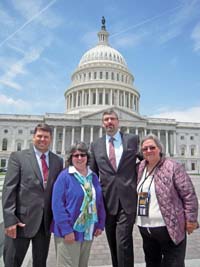By Steve Rothchild, Assistant Deputy Director

For two days in May, council board members Dorothy Moore and Patience Andersen Faulkner, accompanied by staff members Mark Swanson and Steve Rothchild, visited our nation’s capital in an effort to highlight some of the council’s major concerns to the Alaska congressional delegation and several others.
The trip was facilitated by the council’s Washington, D.C. based legislative affairs monitor, Roy Jones.
The purpose of this trip was to continue the general practice of the council of meeting with, briefing, and obtaining guidance from members of the Alaska delegation and others in the federal government on council activities and stakeholder concerns from throughout the Exxon Valdez oil spill region.
The council group met with senior representatives from the U.S. Coast Guard, the Environmental Protection Agency, National Oceanic and Atmospheric Administration, Senate and House committees with jurisdiction relevant to the Prince William Sound oil industry, and the Interagency Coordinating Committee on Oil Pollution Research. The group also met with Alyeska representatives Kim Harb, based in Washington, D.C., and Valdez-based Kate Dugan.
The issues raised were positively received and there were productive discussions on what could be done about them, especially in the new era of federal budget austerity.
Ice detection radar system upgrades
In 2002, the council worked with the U.S. Coast Guard, Alyeska, Prince William Sound tanker operators and other stakeholders to install an ice detection radar system on Reef Island in Prince William Sound to help monitor icebergs in the area. Ice calves from Columbia Glacier and sometimes drifts into the oil tanker lanes, and was a contributing factor in the 1989 Exxon Valdez oil spill. The current Reef Island radar is Coast Guard owned and operated, however the council owns a processor which uses raw Coast Guard radar data to display an ice picture in the Ship Escort Vessel Traffic System’s duty office. The council has been interested in upgrading this processor to newer technology for some time.
Shortly after the group’s return to Alaska, the U.S. Coast Guard approved a request for proposals drafted by the council for purchase and installation of an upgrade to the council’s ice detection signal processor at Reef Island. The council is working with Alyeska and the U.S. Coast Guard to ensure that the new processor will match the technical specifications of the current system and meets approval requirements for installation.
Weather buoy system concerns
The council has become increasingly concerned with the operation and deferred maintenance of several weather monitoring buoys in Prince William Sound. Meteorologists depend on the information from these weather buoys for fine tuning satellite marine forecasts with surface wind and wave information.
Prince William Sound and surrounding coastal waters are known for unique and powerful, localized wind events called “barrier jets” and “williwaws.” These wind events are strong enough to flip smaller boats and to damage or potentially push larger ones, including tankers, onto shore, rocks and reefs. Weather just outside of Prince William Sound can be quite severe causing sea states that can cause harm to tankers and other vessels entering or leaving the Sound.
The primary concern about the weather buoys is that disruptions in service take a long time to repair due to the lack of availability of both ships and personnel to conduct the repairs. Recent examples include a buoy adrift in the middle of the Sound that took six months to replace, and a buoy at Hinchinbrook Entrance which has been operating sporadically since late August of 2012. The council also mentioned their concerns in Prince William Sound are indicative of the overall health of the system throughout Alaska. Currently, only eight of the 20 weather buoys within Alaska are fully operational.
A National Oceanic and Atmospheric Administration, or NOAA, official assigned to the Alaska delegation staff reached out to the council upon our return to Alaska to gather more information about our weather buoy concerns. The council representatives were encouraged by this meaningful dialog following our visit to Washington, D.C. as a great first step in working with NOAA and the delegation towards possible solutions affecting the health of the weather buoy system and the safety of Alaskan maritime transportation in Prince William Sound.